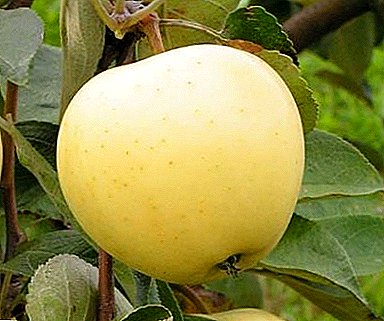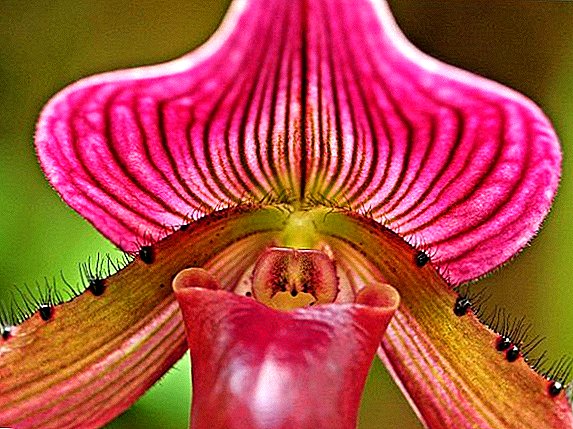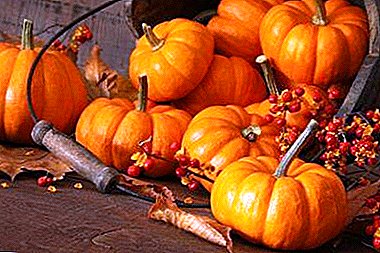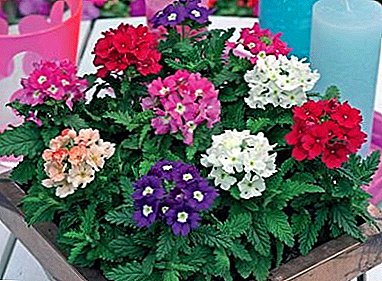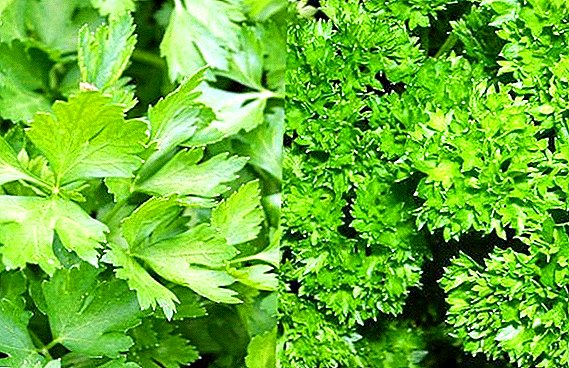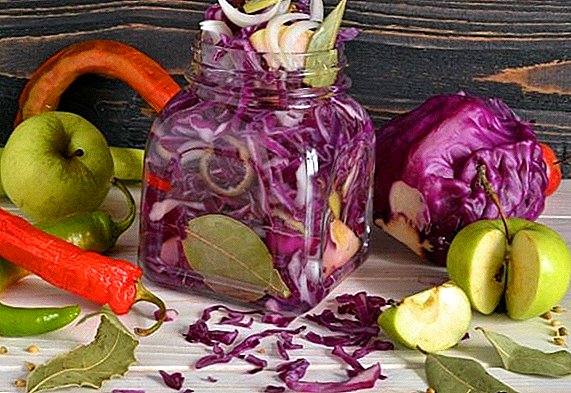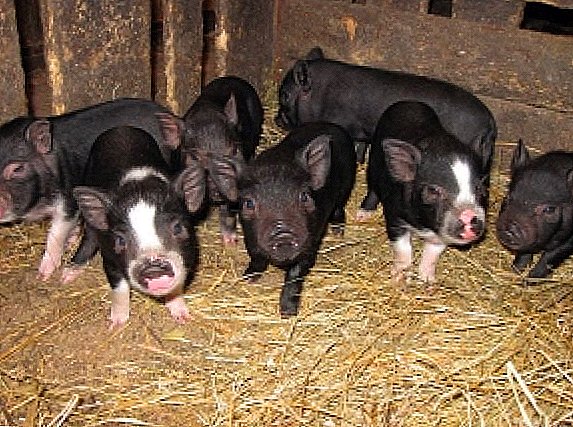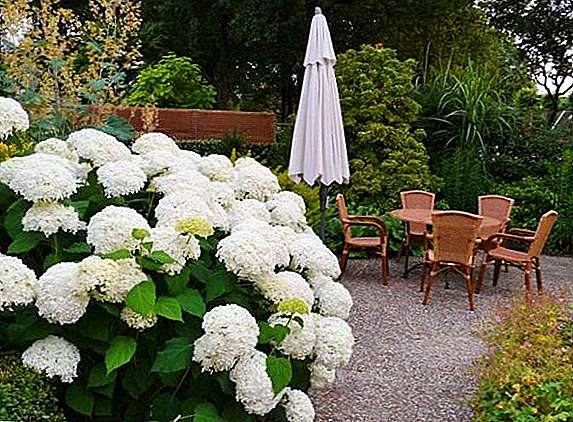 Hydrangeas are very popular among flower growers and plant lovers around the world. To love hydrangea is for what: the plant is unpretentious and abundantly blooms from spring to autumn. Its inflorescences amaze with the variety and beauty of forms. The color scheme is the most extensive (besides, the plant can change its color and shades during one season). Decorative hydrangea also give it curly leaves. Unfortunately, cultivation in the open field in mid-latitudes is too severe a test for most hydrangeas - they are very thermophilic. One of the exceptions is the hydrangea tree (which came to us from the east of North America) - it is cold-resistant and will “register” with pleasure in your garden.
Hydrangeas are very popular among flower growers and plant lovers around the world. To love hydrangea is for what: the plant is unpretentious and abundantly blooms from spring to autumn. Its inflorescences amaze with the variety and beauty of forms. The color scheme is the most extensive (besides, the plant can change its color and shades during one season). Decorative hydrangea also give it curly leaves. Unfortunately, cultivation in the open field in mid-latitudes is too severe a test for most hydrangeas - they are very thermophilic. One of the exceptions is the hydrangea tree (which came to us from the east of North America) - it is cold-resistant and will “register” with pleasure in your garden.
Did you know? The family of hydrangeas (80 species) exists on the Earth for millions of years (from 25 to 70 million). The main natural distribution area is North America and East Asia (China, Korea, Japan). The Europeans first met the tree hydrangea (Hydrangea arborescens) in 1732. A farmer and amateur botanist John Bartam opened it in Appalachia. In 1768, a French round-the-world expedition of Louis de Bougainville brought to Europe from Fr. Mauritius large-leaved hydrangea. With this expedition is connected the story of the acquisition by the plant of its popular name. Military engineer J.-A. Bernarder de Saint-Pierre, caring for the wife of the governor of Mauritius, Madame Poivre, gave her bouquets of beautiful flowers of an unknown shrub, found on the island. The expedition doctor F. Commerson intended to suggest calling the plant on behalf of this woman, but the presence on the expedition of Prince CG Nassau-Siegen and the desire to distinguish themselves prompted him to suggest calling a flower on behalf of the Prince’s sister, Hortense. In Japan, this flower is called "Adzai" - "Purple Sun". The scientific name - "Hydrangea macrophylla" (from the Greek. Literally - "water" and "vessel") indicates the love of this plant for water. But the term "hydrangia" is not widespread.
Tree hydrangea: characteristic
Description Hydrangea arborescens (Hydrangea arborescens) has the following: refers to deciduous shrubs, usually grows to 1.5 m (in America it can reach 3 m). The shoots are tubular, straight, the leaves are green, large (in the form of an ellipse), covered with a glaucous pubescence at the bottom, and serrate on the edge. Blooms profusely with large (15–20 cm in diameter) shield inflorescences (white and cream with greenish hues) from July to October. It is characterized by winter hardiness and fast growth of shoots (from 20 to 30 cm per season).
Tree hydrangea became the basis for breeding a large number of varieties with high cold resistance (with different flowering periods, size of inflorescences, shades, etc.). The most popular are:
- Annabelle (Annabelle) - blooms from June to September, dense round white inflorescences (25 cm). The diameter of the crown - 3 m, height - 1-1,5 m. The leaves fall green in autumn;
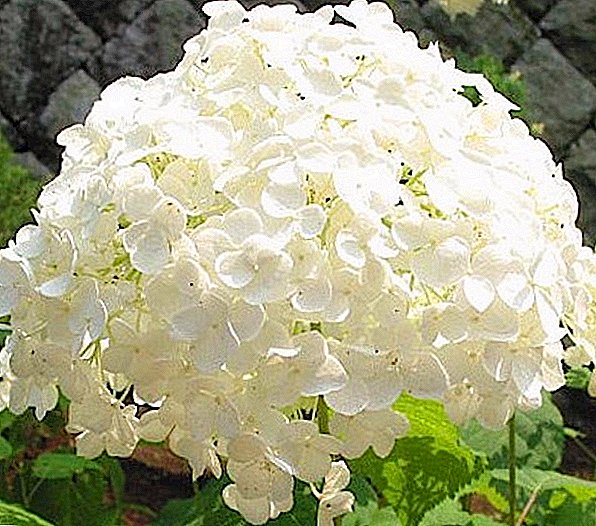
- Pink Annabelle (Pink Annabelle) is a selectively bred pink variety;
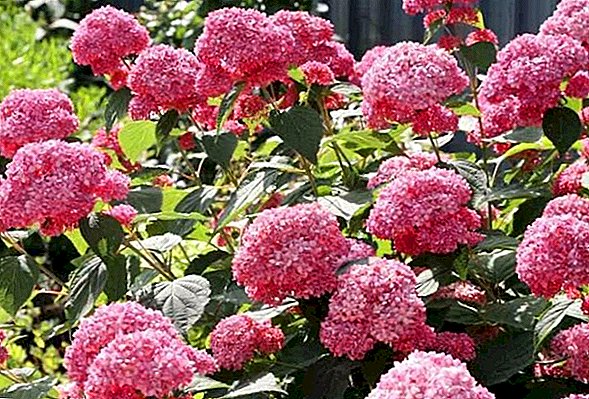
- Strong Annabelle (Strong Annabelle) - has strong shoots capable of holding heavy balls of inflorescences without tying;
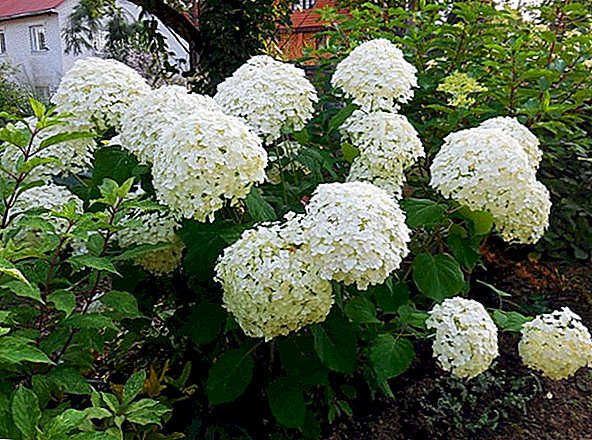
- Sterilis (Sterilis) - has a very abundant flowering, infertile. It can reach two meters in height. Flowers initially have a greenish tint, which changes to a snow-white, blooms from July to October;

- Hayes Starburst (Hayes Starburst) - large inflorescences of terry flowers of white shades, blooms until frost;
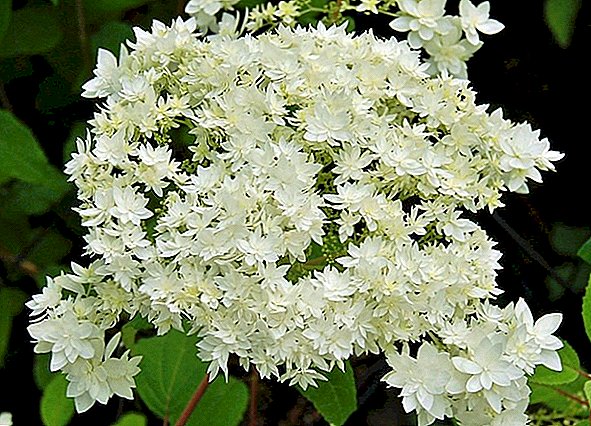
- Pink Percussion (Pink Percussion) - with small inflorescences (up to 10 cm) pink shades.
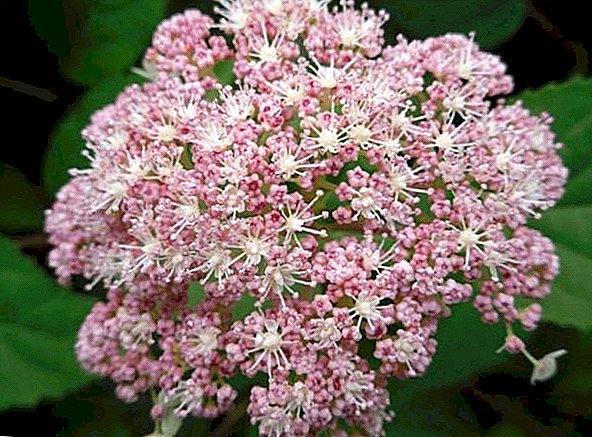
What you need to know when planting a tree hydrangea
In order for hydrangea tree to feel comfortable in your garden, its planting should take into account the preferences of the plant. First of all, it concerns the lighting and the ground.
Important! Hortensia does not tolerate transplants (especially frequent ones) - it “departs” for a long time from the transferred stress, it blooms badly. This circumstance must be considered when choosing a landing site in order to make it permanent if possible.
Plant lighting
Hydrangeas grow well in any light, but practice has shown that:
- under the bright and scorching sun (especially in more southern regions) the size of inflorescences decreases, plant growth slows down;
- thick shadow leads to the fact that the inflorescences do not develop, become rare, flowering decreases.
Soil for hydrangea tree
The composition of the soil hydrangea picky. Most of all, the plant prefers fertile loamy soils with good drainage and high acidity (all mycotrophic plants need soil fungi). Hydrangea tree of all hydrangeas best tolerate the presence of lime in the soil. The soil should not be dense, it should pass air and water well (by adding sand, it should be taken into account that water in such a soil will go to a depth faster). With a lack of acidity, if desired, it can be enhanced with special additives (sawdust, softwood, brown peat, etc.).
Did you know? The intensity and color of the coloring of the inflorescences of hydrangeas depends on the degree of acidity of the soil. If you water the blooming adult hydrangea with four buckets of aluminum sulphate solution (30 g per 10 l of water) twice, the white color of the inflorescences will change to blue, the pink flowers will turn purple.
Planting hydrangeas in the garden
Hydrangea tree will become a decoration of the garden, if properly planted and properly maintained its care. 
When is it better to plant a tree hydrangea
Tree hydrangea can be planted in spring and autumn. In each case, there are pluses. The main plus of the autumn planting of hydrangea is that the planted plant will begin flowering with the onset of spring. Planted in the autumn of large bushes that have a developed root system. In the more northern areas, an autumn disembarkation should be carried out better in September; a shelter should be prepared for wintering.
Planting in the fall:
- does not take much time;
- harden hydrangea, increase its disease resistance.
Planting hydrangea tree spring has advantages in that seedlings:
- take root quickly;
- less sick;
- better winters.
Important! Hydrangeas with a closed root system, purchased in specialized stores, easily carry and transplant transplants, can be planted in open ground at any time from spring to autumn.
Selection of seedlings for planting
Saplings are sold with an open and closed root system (in special containers). Choosing seedlings, you should pay attention to:
- on plant height (should be from 50 to 100 cm);
- on the shoots (there should be 2-3 live shoots);
- on the kidneys (must be whole, large and fresh);
- on the bark (should not be damaged).
 In saplings with open roots, the root system must be developed, whole, without dryness and rot. Their length should be at least 30 cm. If the roots of the seedling are hidden by the container (visual inspection is not available), you should find out when the seedling was transplanted (a recent transplant is undesirable). Immediately before planting, you should examine the earthen room: bright young roots should be visible on it. Gardeners recommend planting three or four year old plants.
In saplings with open roots, the root system must be developed, whole, without dryness and rot. Their length should be at least 30 cm. If the roots of the seedling are hidden by the container (visual inspection is not available), you should find out when the seedling was transplanted (a recent transplant is undesirable). Immediately before planting, you should examine the earthen room: bright young roots should be visible on it. Gardeners recommend planting three or four year old plants. Saplings with open roots should be purchased immediately before planting (if for some reason planting is not possible, the seedling should be placed in a dark place and the roots should be kept moist).
Did you know? In floriculture, there is a practice when planting hydrangea tree saplings to lay a soaked hydrogel in the hole (if you lay dry, then when it swells it will begin to increase in size and push the seedling out). The hydrogel will retain moisture, nourish the roots of the seedling even in hot conditions.
The scheme of planting seedlings hydrangea
Before planting a hydrangea tree in the garden, it is necessary to correctly calculate the planting scheme. Need to consider:
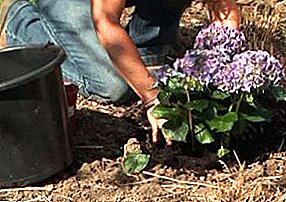 The diameter of the crown of an adult hydrangea is 2–2.5 m. When planting several hydrangeas, care must be taken that the radius is at least 1–1.5 m (this will allow the plants to develop freely and facilitate the approach to care);
The diameter of the crown of an adult hydrangea is 2–2.5 m. When planting several hydrangeas, care must be taken that the radius is at least 1–1.5 m (this will allow the plants to develop freely and facilitate the approach to care);- it is advisable not to plant the hydrangea next to the fruit trees (their roots quickly dehydrate the soil, suppress and prevent hydrangeas from developing).
- preparation of pits. The size of the pits depends on the size of the seedlings (from 25 cm to 50 cm deep and 50-75 cm wide). The larger the plant, the deeper the fossa (the root system of the seedling should fit freely);
- preparation of seedlings (before planting hydrangea in the spring, open roots for a couple of hours should be placed in a warm solution of potassium permanganate, cut long roots. With a closed root system, soak it with water);
- creation of drainage (put a layer of expanded clay, rubble and sand at the bottom of the fossa);
- the creation of a special regime of the soil at the landing site. In the pits (1/3) lay the mixture of humus, peat, compost (1 x 1 x 1) or the mixture for azaleas;
- planting the seedling in the fossa (root neck - at the level of the edges of the fossa), straightening the roots (if the roots are open). With a closed root system - it is necessary to remove the earth from the container and, without touching it, place it in a pit;
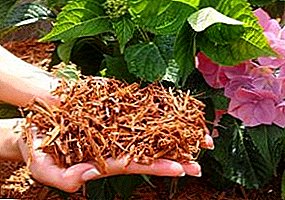 falling asleep with the ground, watering abundantly with warm settled water (no less than a bucket in the hole), filling the ground and lightly tamping the soil around the seedling (not to damage the roots);
falling asleep with the ground, watering abundantly with warm settled water (no less than a bucket in the hole), filling the ground and lightly tamping the soil around the seedling (not to damage the roots);
- mulching for 10-15 cm (a mixture of sawdust, pine needles, straw, paper, burlap, expanded clay is best suited). This will allow better retain moisture, protects against weeds, protects from cold weather.
Important! To prevent infection by infectious diseases and the introduction of pests when mulching the soil, it is necessary to carefully control the quality of the mulch, use proven ingredients.
Hydrangea Treelike: how to care for shrubs
Tree hydrangea is unpretentious - care is reduced to watering, fertilizing with fertilizers, mulching, loosening the soil and pruning.
Watering plants
The scientific name of hydrangeas - "hydrangia" - directly indicates the love of this plant for water. The root system of hydrangeas grows in a horizontal plane, and when the groundwater is deep-seated or during the dry season, the lack of moisture immediately affects the developed aerial part.
For the normal development of hydrangea must be watered:
- regularly. The plant should receive at least 30 liters of water weekly. Mulching the tree circle in combination with natural rainfall will help reduce water consumption;
- soft water without chlorine (hydrangeas especially like rain water). Therefore, water for irrigation needs to be harvested in advance - to defend water supply and / or collect rain in the tank;
- non-cold water (20-23 degrees Celsius);
- in the evening or in the morning;
- without watering the inflorescences when watering (water makes them heavier, and shoots may break).
How to fertilize tree hydrangea
 In the first year after planting, fertilizer for tree hydrangea is not required to be applied to the soil (enough nutrients are put in the hole). In the future, it is necessary to regularly trim up at least three times per season:
In the first year after planting, fertilizer for tree hydrangea is not required to be applied to the soil (enough nutrients are put in the hole). In the future, it is necessary to regularly trim up at least three times per season:
- with the advent of the first shoots (April-May) - complex fertilizer ("Fertika", etc.) or make a mixture of superphosphate and potassium sulphide (30 g per sq. m) and urea (20 g per sq. m);
- with the beginning of budding (mid-June) - a mixture of potassium sulphide (40 g per sq. m) and superphosphate (70 g per sq. m). A good watered nitrogen fertilizer will be a mullein infusion (7 kg of manure per 3 liters of water to insist 4 days) - 1 l per bucket of water;
- during flowering (end of August) - organic fertilizers (compost, rotted manure).
Garden care
The soil needs periodic loosening (so that a dry crust does not form and the access of air and water to the roots is not hindered). Looses the ground (5-8 cm) around a hydrangea with a radius of 60 cm. Loosen it two or three times over the summer. At the same time weeds are weeded.
Trimming Tree Hydrangea
 As practice shows, it is easy to trim a tree hydrangea correctly, but this must be done from the first year after planting (provided that the plant is 4-5 years old).
As practice shows, it is easy to trim a tree hydrangea correctly, but this must be done from the first year after planting (provided that the plant is 4-5 years old).
Pruning allows you to stimulate growth, increases the number and size of inflorescences. The main time for pruning a tree hydrangea is spring (from the moment when the snow melted until the beginning of the leafing).
In the spring, the following types of pruning:
- sanitary (after wintering, dried, frozen or broken shoots are removed);
- rejuvenating (for plants aged 5-6 years and older - cutting under the base of old shoots with weak shoots);
- thinning (struggle with thickening - removal of small, weak, growing in the direction of the center and other shoots).
 Some gardeners recommend the main pruning in autumn. Hydrangea tree does not tolerate pruning before hibernation, and pruning in the fall is undesirable - it may not recover and freeze in winter.
Some gardeners recommend the main pruning in autumn. Hydrangea tree does not tolerate pruning before hibernation, and pruning in the fall is undesirable - it may not recover and freeze in winter.Did you know? Cut off during the autumn pruning inflorescences are perfect for making dry bouquets. When properly dried, hydrangea flowers retain their color: remove all the leaves from the cut shoots, hang them down in buds in a dark room with good ventilation. In order to keep fresh cut flowers of hydrangeas in a vase, it is also necessary to cut off all the leaves, split and burn the end of the shoot.
Reproduction of tree hydrangea
Practicing five ways how to propagate tree hydrangea.
The least used method is reproduction by seeds. In this way, the cultivars of hydrangeas do not multiply - they lose their main characteristics. In addition, the germination of seedlings requires at least three years.  The second method of breeding hydrangeas, the most common - grafting. There are two ways of cutting hydrangeas: lignified and green cuttings.
The second method of breeding hydrangeas, the most common - grafting. There are two ways of cutting hydrangeas: lignified and green cuttings.
In the first case, grafting occurs in early April (before bud break). The seedlings thus obtained are of higher quality (more than 70% of them take root). From the pruned shoots, cuttings with two buds are cut — with an oblique cut below the bud and straight (2-3 cm from the upper bud) above. The cuttings should be planted at an angle of 60 degrees into a mixture of peat and sand (the lower bud should be deepened by 3 cm), kept under a plastic in a greenhouse and watered abundantly.
In the second case, grafting occurs in summer and autumn (best of all - mid-July, during budding). Cuttings are cut with two leaf nodes (tops with buds for cutting are not suitable). Lower leaves are removed, half is cut off from upper ones.  Shank process 30 minutes "Fundazol" (10 g per bucket of water), then the lower slice - a root formation accelerator. Another option is to hold the cuttings in the dark for two hours in Kornevine, Zirkone, and Heteroaukin. Process the upper cut with green paint and deepen into a wet mixture of two parts of peat and one sand (to the top sheet). Cover with a jar (or a cut off part of a plastic bottle with a neck), water twice or more often a week. Rooted such cuttings about 25-30 days. The rearing of hydrangea trees is carried out already next spring after wintering.
Shank process 30 minutes "Fundazol" (10 g per bucket of water), then the lower slice - a root formation accelerator. Another option is to hold the cuttings in the dark for two hours in Kornevine, Zirkone, and Heteroaukin. Process the upper cut with green paint and deepen into a wet mixture of two parts of peat and one sand (to the top sheet). Cover with a jar (or a cut off part of a plastic bottle with a neck), water twice or more often a week. Rooted such cuttings about 25-30 days. The rearing of hydrangea trees is carried out already next spring after wintering.
The third method is reproduction by layering.
This is done before the bud breaks in the spring as follows:
- dig up the ground around the hydrangea and level it;
- choose one of the lowest shoots, cut the leaves (from the ground up to 15 cm);
- make a radial groove (5-10 cm deep), lay escape;
- fasten the shoot with crutches (or press down with a stone), sprinkle with soil (the end of the branch is left outside, you can attach it to the peg) and moisten.

Important! For the fastest rooting, gardeners use different methods - they pull the cuttings in front of the first deeply developed kidney (as the wire grows it will cut into the shoot and roots will appear at the site of damage); remove the bark from the bottom of the dug site.The fourth way is by dividing the bush.
Before planting a hydrangea tree by dividing the bush, pruned outdoor shoots and very abundantly watered. After that you need to do the following operations:
- dig a bush;
- rinse the roots;
- divide the bush (in two or more parts);
- trim the ends of the roots;
- plant separated bushes in a prepared place.
 The fifth way is to fall down the sapling in the autumn (something between the mean how to divide the hydrangea bush in the spring and multiply the layering). For landing the prepared trench with an inclined bottom is used. The seedling is placed so that the roots are more deep, the shoots are higher. Сначала прикапывается корень, побеги раскладываются веером и прикапываются тоже. Поверх можно положить слой торфа (чтобы растение не вымерзло зимой).In the spring, after warming the land, buds on the buried shoots will come to life and grow. At the end of the summer, the hydrangea needs to be dug out and separate new shoots, as a result we get several seedlings (up to 10) with a formed root system.
The fifth way is to fall down the sapling in the autumn (something between the mean how to divide the hydrangea bush in the spring and multiply the layering). For landing the prepared trench with an inclined bottom is used. The seedling is placed so that the roots are more deep, the shoots are higher. Сначала прикапывается корень, побеги раскладываются веером и прикапываются тоже. Поверх можно положить слой торфа (чтобы растение не вымерзло зимой).In the spring, after warming the land, buds on the buried shoots will come to life and grow. At the end of the summer, the hydrangea needs to be dug out and separate new shoots, as a result we get several seedlings (up to 10) with a formed root system.Major pests and diseases of hydrangea tree
Tree hydrangea, with proper care, is rarely affected.
Increased humidity, lowering the temperature can provoke infection with fungal diseases (especially if there is a source of infection) - false and true powdery mildew, white and gray rot. First of all, leaves and flowers are affected. Oxychloride copper (HOM), Bordeaux liquid, Fundazol, Chistotsvet and others help against fungal diseases.
Among the pests, garden snails, spider mites and aphids cause the greatest damage:
- snails affect buds, buds, young shoots and leaves (especially dangerous in early spring, when they climb into wintering bushes). The fight is carried out by manual assembly, the layout of the traps with chemicals (metaldehyde or "Thunderstorm") near the hydrangea;
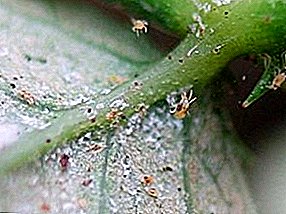 spider mite infects leaves, shoots. Infection occurs with increased air dryness. In the treatment of using various insecticides and acaracides ("Akarin", "Thiofos", "Lightning", "Vermitek", etc.). Of the popular methods of struggle - treatment with soap and mineral oil;
spider mite infects leaves, shoots. Infection occurs with increased air dryness. In the treatment of using various insecticides and acaracides ("Akarin", "Thiofos", "Lightning", "Vermitek", etc.). Of the popular methods of struggle - treatment with soap and mineral oil;- Aphid sucks juice from young shoots, buds. Used in the fight against it, "Inta-Vir", "Aktellik", "Fitoverm" and other drugs. From popular methods - processing infusion of garlic (200 g of crushed garlic in 10 liters of water to insist 3 days, add 40 g of soap).
Did you know? Hydrangea flowers are divided into fruitless, or sterile, and fruitless. Sterile petals attract insects, adorn the plant, can form a border, can be dispersed throughout the inflorescence. During the season, their pigmentation changes - greenish shades turn into snow-white, then pinkish appear. Small in size fruitful flowers are in the center of the inflorescence, and their color does not change.
Tree hydrangea: wintering plants
Tree hydrangea has sufficient winter hardiness. But it’s still not worth the risk (even in mid-latitudes strong frosts are possible in winter), all the more preparation for winter does not take much time and effort:
- spud, add peat and mulch (in the near-stem circle - 25-30 cm);
- to bind shoots (branches of the tree hydrangea do not bend down to the ground - they can break off), drive a few pegs around the bush, attach a spruce fir twig, wrap with agrofiber (lutrasil, spunbond, etc.) and tie around.









 The diameter of the crown of an adult hydrangea is 2–2.5 m. When planting several hydrangeas, care must be taken that the radius is at least 1–1.5 m (this will allow the plants to develop freely and facilitate the approach to care);
The diameter of the crown of an adult hydrangea is 2–2.5 m. When planting several hydrangeas, care must be taken that the radius is at least 1–1.5 m (this will allow the plants to develop freely and facilitate the approach to care); falling asleep with the ground, watering abundantly with warm settled water (no less than a bucket in the hole), filling the ground and lightly tamping the soil around the seedling (not to damage the roots);
falling asleep with the ground, watering abundantly with warm settled water (no less than a bucket in the hole), filling the ground and lightly tamping the soil around the seedling (not to damage the roots); spider mite infects leaves, shoots. Infection occurs with increased air dryness. In the treatment of using various insecticides and acaracides ("Akarin", "Thiofos", "Lightning", "Vermitek", etc.). Of the popular methods of struggle - treatment with soap and mineral oil;
spider mite infects leaves, shoots. Infection occurs with increased air dryness. In the treatment of using various insecticides and acaracides ("Akarin", "Thiofos", "Lightning", "Vermitek", etc.). Of the popular methods of struggle - treatment with soap and mineral oil;